|
Treasures from the Deep
RENO, NEVADA –
During the 1850s, gold was on a
lot of people’s minds. Thousands of goldseekers ventured to California
in hopes of getting rich. Few did, at least not from mining gold. But a
few did get rich from the gold which they loaded onto the S.S. Central
America sailing to New York from Panama.
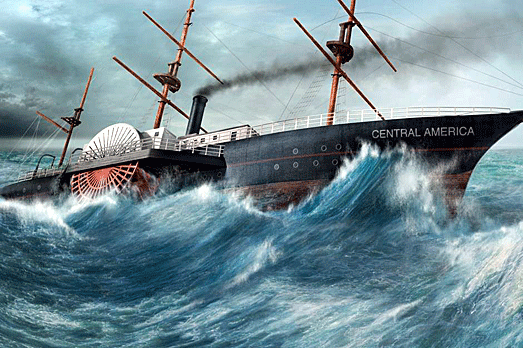
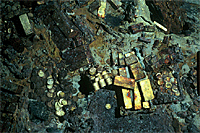 Unfortunately,
the S.S. Central America met her fate when she sank in 7,200 feet
in the Atlantic Ocean off the North Carolina coast during a hurricane on
September 12, 1857. She carried tons of California Gold Rush coins,
ingots, and gold dust from the San Francisco and Northern California
area. The tragedy took the lives of 425 of the ship’s 578 passengers and
crew. The loss of the gold cargo became a major cause of the devastating
financial Panic of 1857 in the United States. Unfortunately,
the S.S. Central America met her fate when she sank in 7,200 feet
in the Atlantic Ocean off the North Carolina coast during a hurricane on
September 12, 1857. She carried tons of California Gold Rush coins,
ingots, and gold dust from the San Francisco and Northern California
area. The tragedy took the lives of 425 of the ship’s 578 passengers and
crew. The loss of the gold cargo became a major cause of the devastating
financial Panic of 1857 in the United States.
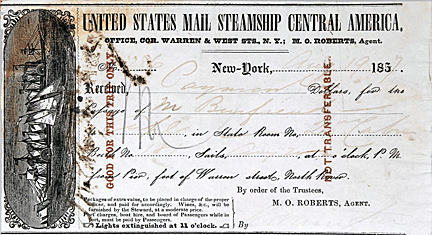
Dubbed the “Ship of Gold,” the wreck of the S.S. Central America
yielded almost 1,000 historic items from the California Gold Rush era.
The real treasure brought up from the ocean floor wasn’t the gold bars
and coins but the hundreds of items that belonged to the passengers and
crew which offer a view into the everyday lives of those who traveled on
the steamship. These items included day-to-day clothes, such as miners’
work pants and long underwear, and even fancier cravats and spats.
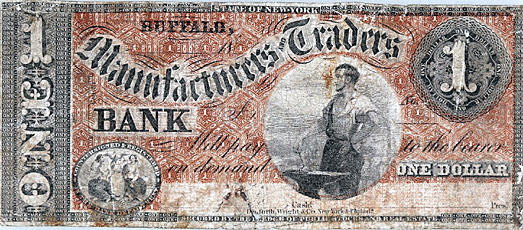
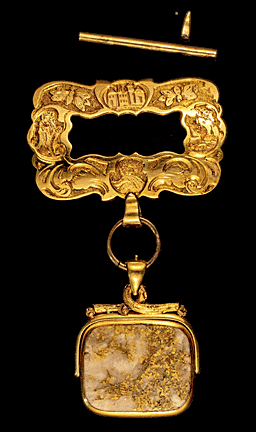 Among
the notable, recovered items were a unique lid to the remnants of the
oldest known Wells Fargo treasure shipment box, clothing including a
pair of the oldest known Gold Rush-era canvas work pants jeans with a
button fly that may have been made by Levi Strauss in his early years in
business (sold for $114,000), three Brooks Brothers logo shirts,
photographs; jewelry made from California Gold Rush native gold, with
quartz and gemstones; and personal grooming items such as combs,
hairbrushes, perfume bottles, buttons, and buckles. Among
the notable, recovered items were a unique lid to the remnants of the
oldest known Wells Fargo treasure shipment box, clothing including a
pair of the oldest known Gold Rush-era canvas work pants jeans with a
button fly that may have been made by Levi Strauss in his early years in
business (sold for $114,000), three Brooks Brothers logo shirts,
photographs; jewelry made from California Gold Rush native gold, with
quartz and gemstones; and personal grooming items such as combs,
hairbrushes, perfume bottles, buttons, and buckles.
One of the important, recovered jewelry items was a large 18-karat gold
ore engraved brooch that prominent San Francisco businessman Samuel
Brannan was sending to his son in Geneva, Switzerland, as a gift to the
son's teacher. It sold for $49,200.
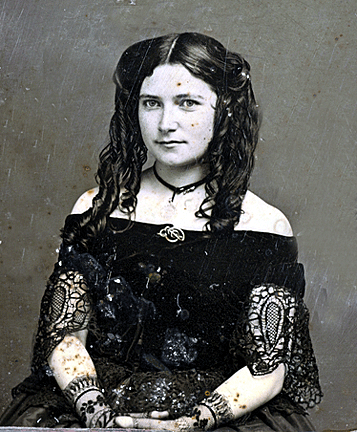 The
scientific mission recovery team discovered the pair of jeans in a trunk
belonging to passenger John Dement who survived the sinking. They also
recovered some 19th-century photographs—one a daguerreotype metal plate
photograph of an unidentified young woman which they nicknamed, “Mona
Lisa of the Deep,” discovered in a scattered pile of the ship’s coal. It
sold for #73,200. The
scientific mission recovery team discovered the pair of jeans in a trunk
belonging to passenger John Dement who survived the sinking. They also
recovered some 19th-century photographs—one a daguerreotype metal plate
photograph of an unidentified young woman which they nicknamed, “Mona
Lisa of the Deep,” discovered in a scattered pile of the ship’s coal. It
sold for #73,200.
Other items recovered included pistols, brass luggage tags, passengers’
ticket receipts, galley utensils and dishes, wine and spirits decanters
that seemed to have been a standard amenity in the first-class
staterooms, eyeglasses in solid gold frames, and even chewing tobacco in
a pouch apparently from the 1851 London World’s Fair.
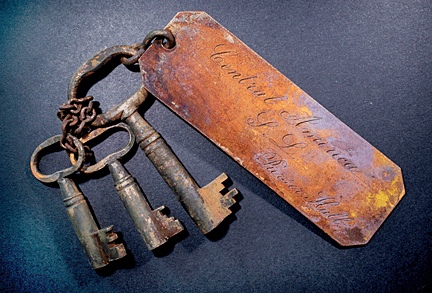 Another
recovered item was the S.S. Central America brass name tag
attached to a set of keys that belonged to the ship’s purser. Because
these keys were larger than the type usually used for passengers’ rooms,
the team surmised that they were for the locked room where the gold
cargo had been stored on the ship Another
recovered item was the S.S. Central America brass name tag
attached to a set of keys that belonged to the ship’s purser. Because
these keys were larger than the type usually used for passengers’ rooms,
the team surmised that they were for the locked room where the gold
cargo had been stored on the ship
Nearly 7,000 collectors from the U.S., Canada, South America, and Europe
bid a
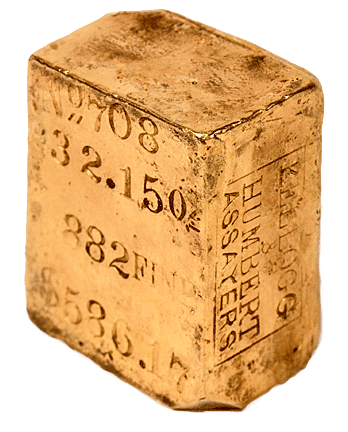 whopping
total of $1.1 million to acquire 422 lots of historic, California Gold
Rush-era artifacts recovered from the 1857 sinking of the S.S. Central
America, the fabled “Ship of Gold.” The two-day auction, held on March 4
and 5, 2023, and conducted by Holabird Western Americana, occurred in
Reno, Nevada and online. whopping
total of $1.1 million to acquire 422 lots of historic, California Gold
Rush-era artifacts recovered from the 1857 sinking of the S.S. Central
America, the fabled “Ship of Gold.” The two-day auction, held on March 4
and 5, 2023, and conducted by Holabird Western Americana, occurred in
Reno, Nevada and online.
Many bidders had been waiting for these extraordinary items to come on
the market since a team of scientists discovered the legendary,
submerged ship in 1988, and Life magazine proclaimed it America’s
greatest treasure ever found.
One of the auction highlights was a massive 32.15-ounce gold bar created
in San Francisco by prominent Gold Rush assayers John Glover Kellogg and
Augustus Humbert. The two-pound gold ingot sold for $138,000, far above
its current gold content value of about $59,000. The assayer’s value at
the time it was created was $586.17.
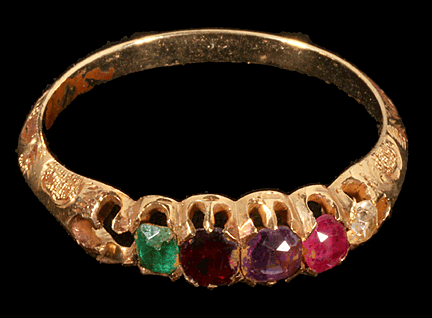 Among
the 45 other recovered jewelry pieces in the auction was a REGARD ring,
named for the first letter of each of the five gemstones it contains:
ruby (missing from the ring), emerald, garnet, amethyst, ruby, and
diamond. It sold for $14,400. A set of gold cufflinks brought $12,000. Among
the 45 other recovered jewelry pieces in the auction was a REGARD ring,
named for the first letter of each of the five gemstones it contains:
ruby (missing from the ring), emerald, garnet, amethyst, ruby, and
diamond. It sold for $14,400. A set of gold cufflinks brought $12,000.
Gold wire-rim eyeglasses retrieved from the wreck site a mile-and-a-half
below the Atlantic Ocean surface sold for $13,800.
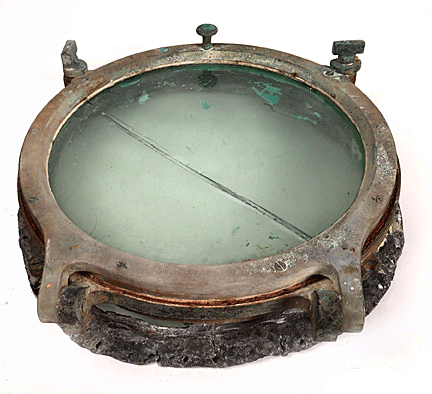 A
porthole from what is believed to be Captain William Lewis Herndon’s
topside cabin went for $22,200. Lumps of recovered ship’s coal sold for
hundreds to thousands of dollars each depending on size. A
porthole from what is believed to be Captain William Lewis Herndon’s
topside cabin went for $22,200. Lumps of recovered ship’s coal sold for
hundreds to thousands of dollars each depending on size.
Six applied-top beer bottles, some still with original beer contents,
sold for an average of $1,087 each. And the Havana cigars that
passengers smoked with those beers went for $720 a pair—36 went up for
bid.
This was the second and final auction of never-before-offered artifacts
from the S.S. Central America. The first auction of 270 other items this
past December attracted nearly $1 million in winning bids.
<
Back to Antiques News
Next Article > |
